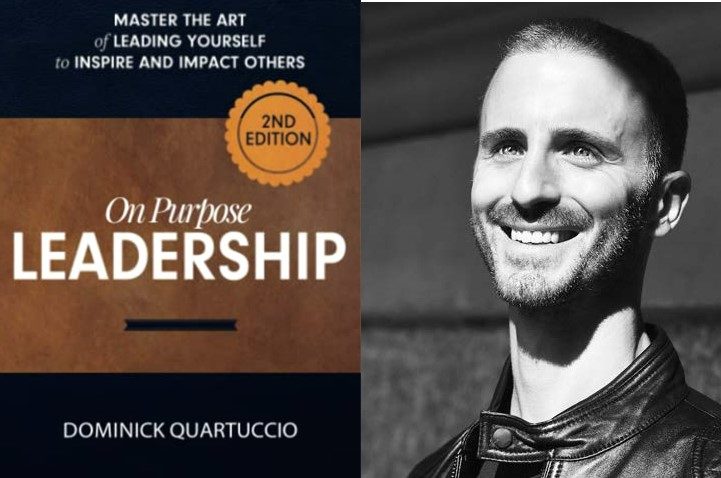Excerpt from “On Purpose Leadership: Master the Art of Leading Yourself to Inspire and Impact Others” by Dominick Quartuccio. Copyright © 2021 Dominick Quartuccio. Reproduced by permission of TCK Publishing.
As someone who has worked with hundreds of leaders and teams, in both business and personal environments, I see two connected problems in how leaders, like Whitney, are leading today.
PROBLEM #1: Leaders are trying to lead others before mastering the art of leading themselves.
Leaders always ask me the same three questions:
- How do I get my people to change?
- How do I get my people to act with more urgency?
- How do I hold my people accountable?
If you’ve paid close enough attention, you’ll realize there’s a fatal flaw in all of these questions: They assume the answers lie within the followers, not the leader.
There are legions of leaders today running around and pointing the finger at everyone else but themselves when it comes to leading change, doing what’s uncomfortable and executing on the most important priorities. There are a select few who point those fingers at themselves first.
These are what I call On Purpose Leaders.
On Purpose Leaders know their “why,” make every decision with intentionality, and live the example they wish to inspire in others.
- Instead of asking, “How do I get my people to change?” they ask, “How do I change?”
- Instead of asking, “How do I get my people to ask with urgency?” they ask, “How do I act with urgency?”
- Instead of asking, “How do I hold my people accountable?” they ask, “How will I hold myself accountable?”
Too many leaders have not yet mastered the art of leading themselves, yet they expect to be masterful leaders of others.
It simply doesn’t work this way.
Every inconsistency, blind spot, gap in integrity, and substandard behavior you have in leading yourself will be amplified in the levels beneath you.
This will be showcased in your teams’ behaviors and results.
You must master the art of leading yourself before you can effectively lead others.
PROBLEM #2: You cannot master the art of leading yourself without connecting to your purpose, and you cannot see your work as the enemy to purpose.
Executives, entrepreneurs, and community leaders constantly speak to me about their growing desire to fi nd a deeper sense of purpose in their lives.
They want more than just a career and a paycheck.
They are seeking meaning, fulfillment, and aliveness.
Don’t you?
But perhaps you’ve been sold a story that you’re only truly free to pursue purpose once you’re financially independent. Either that or you must disrupt an unreasonable amount of your life for work that pays little or far less than what you earn presently.
Many of the people I speak to believe purpose is some unattainable fantasy that exists in a parallel universe or must be a massive undertaking that’ll take years or decades to realize.
They see their present-day work as the enemy; a necessary evil to meet mortgages, accelerate careers, and support families.
They’d really rather be doing something else.
Again, how about you?
If you’re disconnected from a sense of purpose, then an essential part of your life force is left untapped!
You are leading with only a fraction of your potential.
Your teams will feel it.
Your results will reflect it.
You cannot master the art of leading yourself without connecting to your purpose.
You must see your present-day work as a portal to your purpose, right here and now, in order for you to
lead from your highest potential.
Act now!
Why it’s important you act, now!
To explain why these two problems are such an issue, and why you must do something to change right now, let me tell you another story.
For the first 15 years of my career, I led sales teams in the high-pressure world of financial services for Prudential, a Fortune 100 firm. After leaving the industry to start my own consulting business, I’ve made a big part of my living coaching, speaking to, and training the financial services industry.
Over these last two decades, I’ve witnessed tremendous change ripple through an industry that was predicated on – and quite frankly, addicted to – stability.
There’s been a dramatic shift in industry regulations, which has led to margin compression, rapid consolidation, and mass layoffs. This has resulted in much more work on the backs of far fewer people.
Before that shift, this was an industry where people spent their entire 30-, 40- and even 50-year careers without much dramatic change. Movements were incremental. Managing what already existed – which was often multiple billions of annual revenue – was valued over leading change, which could often bring risk and disruption.
All of a sudden, the industry found its financials shifting rapidly, but its people were still largely clinging to the
old promise of stability, familiarity, and “what’s always worked before.”
All of a sudden, lifelong “managers” were being asked to lead change in organizations filled with people who’d been raised in a culture of preserving the status quo.
These managers would say all the right things, but their teams wouldn’t respond because the manager wouldn’t
be modeling the behavior he or she spoke of. These managers would then get frustrated at the lack of movement in their teams, pointing the finger at their people for being unwilling to change or not acting with enough urgency.
That’s when I noticed a troubling theme emerge: These managers were embodying the very behavior they wished to change in their people.
Like Whitney from the opening story, they themselves still had deeply rooted desires for comfort, stability, and sticking with what’s always worked for them.
They welcomed change, as long as it was incremental and felt safe.
But their businesses demanded transformational change.
This isn’t just relegated to financial services. Every industry is under tremendous pressure to adapt, grow, and speed up in accordance with our technologically hyper-charged and ever-changing world.
There’s a second big theme that’s emerged as I’ve worked alongside leaders of all businesses: More and more people are seeking a deeper sense of purpose in their lives and view the all-encompassing demands of their work to be the barrier to meaning and fulfillment.
People are working longer hours, always connected to their devices and with a relentless emphasis on nonstop productivity.
That never-ending, intense pressure is causing people to ask: “Is this worth it?”
As people are grinding their ways to better business results at the expense of their health, relationships, and personal freedoms, the need for a deeper sense of purpose becomes increasingly more crucial to staying fully engaged in their lives.
—
I’ve worked with incredible leaders – like Whitney – who came to the awakening that all of the success of their leadership hinged upon looking inwards first.
When you connect to purpose and master the art of leading yourself, leading others becomes easier and more fulfilling.
Your mere presence will inspire others to raise their standards and meet you where you’re at. This book is your guide to leading On Purpose. It requires you draw a line in the sand, right now, and step into a new way of leading.
“On Purpose Leadership: Master the Art of Leading Yourself to Inspire and Impact Others” is available now and can be purchased via StartupNation.com.






